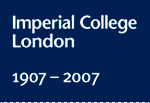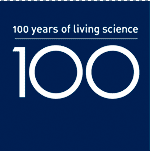Jim Platt
(Mining Geology 1957-60)
Jim regales memories of defending the Chaps Club and the mascot of the Royal School of Mines
I started as a student in the Mining Geology Department of the Royal School of Mines (RSM) in the early autumn of 1957, having left Sir James Smith’s Grammar School at Camelford in North Cornwall back in the preceding summer. My home village in North Cornwall, where I was born and had lived exclusively hitherto, was Port Isaac, an isolated coastal fishing village of consummate rural backwater charm. Port Isaac and district made a great free range environment in which to grow up, although neither it nor school at Camelford prepared me much for coping with the wiles of the “Big Smoke”.
London truly was the Big Smoke in those days with the persistent incidence of pea soup-styled fog an integral element of city life.
I arrived in London well conditioned to keep on wearing the heavy cloak of deference to authority that had been draped on me by, among others, my Grammar School headmaster and his staff, a succession of Port Isaac vicars and a host beyond counting of those who set themselves up as my elders and betters and who never tired of telling me that they had not fought a war in order to enable me to behave in what they considered to be a less than disciplined manner. The cloth they had cut for me however began to fray rather quickly when I took up my allegiance with the Royal School of Mines.
I quickly discovered that my strong Cornish spoken accent served to characterize me as a country yokel cum village idiot in the understanding of rather a lot of the people that I was encountering in London, but I could live with that, and was happy to concede that they might have had a point. After a while the customary “Arr, Jim lad” reaction to my voice became familiar enough for it not to matter any more.
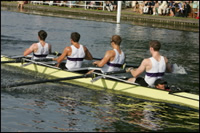 Among the Imperial College clubs that I joined as a fresher were the Rowing Club, the Boxing Club, and the Socialist Society. The latter no doubt represented my break from North Cornish conservatism, although frankly the Royal School of Mines was then as conservative an institution as could be imagined, and I have to admit to receiving counsel from various members of that institution warning me to maintain my left wing leanings at a low profile. The great bonus of the left wing however was that I once attended a meeting at which the guest of honour was the world famous American civil rights activist and actor and singer extraordinaire, Mr Paul Robeson. He regaled those of us present with a short speech and unaccompanied by music sang a large number of the songs for which he was so celebrated. I got to shake his hand at the end – and remember the moment always.
Among the Imperial College clubs that I joined as a fresher were the Rowing Club, the Boxing Club, and the Socialist Society. The latter no doubt represented my break from North Cornish conservatism, although frankly the Royal School of Mines was then as conservative an institution as could be imagined, and I have to admit to receiving counsel from various members of that institution warning me to maintain my left wing leanings at a low profile. The great bonus of the left wing however was that I once attended a meeting at which the guest of honour was the world famous American civil rights activist and actor and singer extraordinaire, Mr Paul Robeson. He regaled those of us present with a short speech and unaccompanied by music sang a large number of the songs for which he was so celebrated. I got to shake his hand at the end – and remember the moment always.
I joined the Rowing Club on the basis of having done a fair amount of rowing already both in and around the Port Isaac harbour. It soon became clear that that particular kind of rowing had about as much in common with rowing in an eight on the Thames as my political views had with those of Mr David Irving, who was a student in Guilds at the time and by no means committed to maintaining a low profile.
I was put to row in the number four position of the RSM Lowry boat crew (the second crew of two, the first being the Morphy crew) in the annual winter river race versus crews from Royal College Science (RCS) and Guilds between Hammersmith Bridge and Putney Bridge. As far as I recall the RSM Lowry boat came third in each of the three annual races when I was part of its crew. It wasn’t so terrible to be beaten by Guilds, but to come in behind Royal College RCS (or “RCS!” as we of the RSM used to call out in high falsetto) – now there was humiliation.
I learned that rowing in an eight was a tough sport. It offered no opportunity for any crew member in a race to take it easy for as much as the blink of an eye. The Emeritus President of the Rowing Club, a grand old boy named Charles Bristow who always togged himself out in blazer and cap would look at prospective rowers and say “You’re big enough and you’re ugly enough so you ought to be able to row!” And he was right. At the annual Rowing Club dinner wagers were made on the length of time Charles’s speech would take. The shorter odds always favoured the longer times!
Practice for the Lowry race took place 3 times a week in the winter term at more or less first light in the cold of morning. It took dedication to get up and face it. Once the practice was over we had to rush back to the RSM to be in time the first lecture of the day, which in my first term was always on Assaying and delivered by Dr D.A. Pantony. When the scheduled time for him to start came along, Dr Pantony locked the lecture theatre doors, having no sympathy for latecomers. In one of his first lectures to us he came out with the word “bul****t”, which made me think that now I was really moving with the big boys.
Since I had boxed in church club competitions in North Cornwall with a certain amount of success (or of the notoriety which in boxing goes hand in hand with success) I was a natural to enter the Boxing Club. I boxed for no better reason that because I could, but never took the “sport” at all seriously. Anyone who is unafraid and prepared to take a punch can make a go of it at boxing.
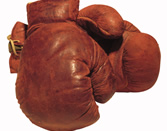 The great Imperial College boxing competition was known as the Rector’s Cup and took place every year I think in February in the form of a tournament between the three constituent colleges. At that time the student body I think was about three thousand strong - consisting of up to two thousand at RCS!; heading for a thousand at Guilds, and two hundred and fifty at the RSM. Though the RSM was numerically at the foot of the totem pole it had no impact on the RSM in the Rectors Cup, as we regularly took the tournament by storm. This feat of conquest was achieved by us entering more contestants for the tournament than the other two colleges combined were able to muster. It was considered a matter of duty for any “Mines” man to declare himself ready to box. With sufficient entrants to swamp the opposition, winning a few of our bouts by walkovers got us off to a good start.
The great Imperial College boxing competition was known as the Rector’s Cup and took place every year I think in February in the form of a tournament between the three constituent colleges. At that time the student body I think was about three thousand strong - consisting of up to two thousand at RCS!; heading for a thousand at Guilds, and two hundred and fifty at the RSM. Though the RSM was numerically at the foot of the totem pole it had no impact on the RSM in the Rectors Cup, as we regularly took the tournament by storm. This feat of conquest was achieved by us entering more contestants for the tournament than the other two colleges combined were able to muster. It was considered a matter of duty for any “Mines” man to declare himself ready to box. With sufficient entrants to swamp the opposition, winning a few of our bouts by walkovers got us off to a good start.
My weight, at twelve stone nine pounds was two pounds above the light heavyweight/heavyweight margin of twelve stone seven pounds. I liked being classed as a heavyweight as the competition tended to be big bellied and ponderous and thereby simple enough to run around and pick off.
In my first Rector’s Cup the RSM wanted me to box as a light heavyweight, and the shortness of the notice that I had to step down a division meant that I had to shed a few pounds over a weekend. That I managed, was a tribute to not eating anything and to sitting for long periods in a bath of ultra hot water reading western novels.
The result was that I entered the ring almost too depleted to hold my guard up, was lucky to survive round one and ended up being counted out in round two when the referee stopped the fight in my opponent’s favour. I thought it would be appropriate to make a protest the decision, but in truth I was glad that the bout was over. The one good thing was that I went down to a man from Guilds, leaving me thankful for the small mercy that an RCS man was not in the opposite corner.
My boxing prowess (or lack of the same) had a couple of significant consequences however; the first of them being that it gained me the position by selection to be the first guardian of a new RSM mascot. My responsibilities involved carrying the mascot during its outings for demonstrations, rag days and so on and of being charged with defending it at all costs should any mob from Guilds or RCS make a breakthrough intent on stealing it.
The mascot was a Michelin man, purloined by a free spirit from its former place of honour atop the cab of a lorry dedicated to serving Michelin customers. The individual hoops of its jovial body were subsequently painted alternately in the white, yellow and black colours of the RSM. Its given name was “Mitch”, appropriate to its origin of course, but also relevant to the good name of the Dean of the RSM and Professor of Mining, Professor J.C. Micheson. The Professor, also known informally as Mitch, was a consummate gentleman with a highly ascetic disposition, and was (not unjustifiably as a result) spoken of as “the orange juice Dean”.
As a non-smoker I knew only too well how my declining an offer of a cigarette that seemed to be so commonplace whenever two or more people met was viewed with a jaundiced eye by one’s companions as being somehow unmanly, and perhaps as a consequence I took pains to never fall into that category where beer was concerned. No matter how many pints had been downed already, conventional philosophy deemed that there was always room for another.
Not long after the arrival of Mitch the mascot it was decided with an element of great spontaneity after an RSM Union meeting that Mitch was to be carried along the RSM first floor through into Guilds and then onwards to make an exit through the Guilds entry on Exhibition Road. Perhaps those present at the Union meeting had appreciated some particularly welcome readings (“Eskimo Nell” for example) by the Hon. Pornographer from the great copper sheet bound book of verses and yarns that he held in his custody. (I wonder what happened to that book).
We charged into Guilds in a grand phalanx. I was at the centre holding Mitch. Our expectation was that we would be through Guilds and out before anyone likely to object was aware of what was happening. However, the best laid schemes of mine and men aft gang agley.
We very quickly met with intense opposition to our advance. Guildsmen poured into the corridor and we were soon fighting for every inch of gain. As the numbers facing us increased our push ground to a halt. It was a matter flailing arms and much vocal invective for a while, but then someone at the rear of the RSM attack squad had the brilliant idea of breaking out a fire hose and turning it on our opponents. At which the jet tumbled Guildsmen like ninepins. Not to be outdone however, they brought a second fire hose into play and high pressure water was suddenly flying hard in all directions like, well, high pressure water I suppose.
It seemed only logical to get hold of and let a few fire extinguishers enter the fray – why not?
At that point along came the literal dampener with the sudden appearance of various members of both the RSM and Guilds staff. The affray had little option but to fizzle out ignominiously. The corridor was by then running a couple of inches deep in water; extinguisher foam coated several of the glass display cases along the way, effectively making a mystery of their contents. Meanwhile back in the RSM building the staircase between the first and ground floors was giving an acceptably good imitation of a waterfall.
Following a subsequent high level enquiry led by inter alia the orange juice Dean, all of us who were involved were identified as guilty culprits. We were each fined the sum of ten pounds – living then on less than five pounds per week I found it to be a punitive amount of money. Despite threatening noises no one among us was sent down which was the fortunate thing, although we were all sworn to be on our best behaviour thereafter.
A chance would be a fine thing.
As far as I am aware, that foray into Guilds was Mitch’s only such outing of its kind. It was strongly suspected that influential people on the RSM staff had not been altogether too averse to the spirit of our endeavour to put one over on Guilds, but we all knew better than to try it on again.
The second great consequence of my boxing and incidental Mitch-guardian activities was that I was elected to membership of the RSM Chaps Club in the spring of 1958. The Chaps Club was described to me by our surveying drawing instructor, the late great Ben Parker, as a “sporting institution”. Its membership was limited to about forty persons in college, and election was by invitation only. Candidates for membership were allegedly selected from among those considered to have made or be making a decent contribution to RSM life in general. The dedicated pint lifting expertise of Chaps Club members was legendary and there is little doubt that to the Union Bar they certainly contributed much more than their fair share.
At my inaugural dinner I was required to down the contents of a traditional oaken loving cup (a singular misnomer) as it made its rounds of the dining hall in the Imperial College Union Building. The catering Manager was at that time a certain Mr Mooney with whom it would be fair to say many students enjoyed a love-hate relationship. Mr Mooney could relax at dinners such as that of the Chaps Club in the sure knowledge that any shortcomings in the fare on offer would be entirely drowned in a surfeit of beer.
The arranged trick with the loving cup was that it was always brim full when it reached a new member. The contents must have been at least three pints and putting all of that away in one go with the assembly chanting “Down! Down! Down!” was no mean feat. I am pleased to report that I swallowed the lot, but not for long as it almost immediately came back up again, bearing with it the masticated sum of Mr Mooney’s recently delivered repast. I was conscious of my heaving up triggering a sympathetic reaction from a few others in the hall.
Fleeing from the scene as if pursued by a bear, I dashed through the door at the back of the hall only to discover that a lengthy flight of concrete steps was at my feet and I had no time to halt my momentum. I performed what was known as an “ass over tip” flip and in the manner of a stuntman tumbled from top to bottom of the staircase in an instant. I hit the bottom “bloody but unbowed”, in the process of which I learned the object lesson that if you have to fall down a flight of stairs it is better for your health to be drunk than it is to be sober.
In his introductory speech about me later on at the dinner, one of my two sponsors Doug Owen (the other being Pete Grimley) described me as “having a lot of guts” much of which he said had been seen decorating Mr Mooney’s floor not long since.
When I attended a Chaps Club dinner as an “old boy” a couple of decades later I was glad to see that the practice regarding the loving cup was for a large plastic bucket to follow hard on its heels as it made its round of the new members. With a certain amount of satisfaction as the bucket passed by me I saw that the “sick bucket” as it was known had lived up to its name.
The momentous event written large in the Chaps Club calendar immediately following my accession to membership was the Chaps annual Derby Day outing. Thus did I join a goodly number of suitably raucous fellow-members of both past and present vintage to journey to Epsom Downs on Derby Day in 1958. We travelled in an open topped double-decker bus hired for the occasion from London Transport.

Photo above: Chaps Club Derby Day 1959
Our company assembled at the Union Bar at precisely eight am for the purpose of downing a golden sequence of breakfast pints. All of us were neatly suited up with our chocolate and light blue striped Chaps Club ties on prominent display and grey top hats made from compressed paper pulp on our heads. Some of the top hats fitted and some didn’t, but it was the overall impression that counted.
The weather was perfect for the occasion, the sun soft and warm, the few clouds in view were white and fluffy. There was just enough breeze to be pleasant. The grass seemed impeccably green.
A couple of large pre-tapped barrels of beer were positioned securely on the lower deck of our bus – this was reckoned on the basis of the experience of previous such outings to be sufficient unto the day to cope with the steady battle against thirst not only on the road out to Epsom, but also from the viewing position at the race course, and for the unflagging stalwarts on the return journey into the bargain.
Time, aided by my share of the contents of the barrels on the day has acted to blur my memory of the bulk of the day’s activities. The identity of the winner of the big race is somewhere beyond recall. The remembered sense of the day is of a riot of amiable colour, of fairground sideshows, of meeting up that superb middleweight champion boxer Terry Downes, of unnamed horses running on green turf, of a slippery chicken lunch, of all my bets placed on also-rans, and of being sick (it was getting to be a habit) probably more than once or even twice.
The return journey to London got off to a slow start. The mass of traffic leaving the racecourse would move for a few yards at a mere crawl and then stop for a while before summoning up the motivation to carry on and gain a few more yards.
Our bus was locked into this intermittent procession directly to the rear of a large limousine of considerable quality. Its large back window sloped elegantly into a great curve of boot. Through the window we could see that the rear seat of this handsome vehicle was occupied by two young ladies, one being blonde and one brunette. They were both of such distracting elegance that a number of the Chaps (of whom I give you my word vicar I was not one) felt obliged to gather at the front end of the upper deck of the bus, whistling and catcalling to attract the ladies attention.
When this attempt at communication failed to elicit a response, it was decided to that a well-aimed stream of aerated water directed at the car from a fully charged soda-siphon might do better. The application of one siphon to the task led to the involvement of a second, and then a flour bomb (one of a number that appeared to have been brought along just in case a contingency arose calling for their use) was added to the equation. Thus do conflicts escalate.
When the traffic pulled up for its next breather, the right door of the limousine, the boot and rear window of which were by then coated with a thin and sloppy dough, was open precipitately and a certain individual who looked like a much larger, much younger, and more muscular version of Arthur Mullard crossed by Freddie Mills, stormed towards our bus with evidently hostile intent advancing. Ray Gibbons, the Chap who was unlucky enough to be first in the firing line on the back step of the bus, received the impact of this individual’s right fist full on his nose and promptly extended himself in the collected swill beneath the two beer barrels.
Much confusion and much more shouting then ensued. The entire Chaps Club complement piled off the bus to confront Ray’s assailant, only to quail back in a huddle suggesting that discretion was the better part of valour when his mountainous dimensions loomed over them.
Someone then remembered that someone who had boxed in the Rector’s Cup (a lack of distinction notwithstanding) was right there within the Chaps Club ranks and since that someone was me, I found myself pushed to the front line to confront Arthur and Freddie’s gigantic look-alike. My immediate wish was that I could somehow be transported back to Port Isaac. “Beam me up Scotty!”
“Our man is a champion boxer!” one of the Chaps shouted at Arthur from a safe location at the back of our group. Disaster for me lay in the fading echoes of this gross untruth, however fate took a kind hand when a back doors of the limousine was thrown open and a small ball of bristling fury came hustling through it screaming, “Let me deal with him!”
This newcomer to the fray leapt directly at me, grabbed hold of my Chaps Club tie, and pulled my face down towards his own which I was interested to see was literally purple with rage. Flecks of spittle flew from his mouth and few of them failed to miss me. There was an unctuous scent about him that enveloped me in the manner of a clammy handshake. I was suddenly shocked to find myself staring into the bloodshot eyes of a very familiar face indeed, belonging to none other than one Raymonde, otherwise known as Mr Teasy-Weasy, a high-society hairdresser who had won huge national fame as a television celebrity.
It is fair to say that Mr Teasy-Weasy’s was one of the best known faces in the whole country at the time, and there he was, with his bouffant hair, spiked moustache, smart cravat and preening flamboyance only a few scant inches away from my eyes. My Chaps Club tie was held captive by the very hands, scant inches from my throat, which tended the coiffures of the rich and famous.
We looked at each other, he wide-eyed and glaring and me still trying to shake off disbelief for what felt to a very long instant but probably wasn’t. Here at last, I was thinking, was someone I could take down. What could I do? Inspiration struck me. “I’m sorry,” I said to him, “I can’t fight with hairdressers”.
Then we heard an impasse-breaking yell to the effect that traffic had begun to move again. Mr. Teasy-Weasy’s reaction was to release my tie and scuttle back to his car. Arthur, with a final dynamic full fisted gesture at us, then did the same, fortunately unaware that several reciprocal gestures involving only two fingers were aimed at his back. We were greatly relieved, by the fact that the traffic kept moving from that moment on.
Perhaps there was some residual honour won by all parties involved in the confrontation, although I couldn’t help but see our return journey as a kind of retreat and under the evening sun I was ready to concede that the essence of victory at least belonged to Mr. Teasy-Weasy. I didn’t doubt that that was the way he was going to tell it.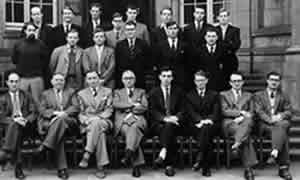
About thirty years later I heard indirectly that the Chaps Club was alleged to have been involved in another Derby Day contretemps which this time involved both doing it in the streets and frightening the horses at the same time. Whatever took place was enough to justify reporting by one or more organs of the national press.
Photo right: Mining Geology Final Year (1960)
I was shown a clipping from the “Daily Telegraph” (not my paper of choice) declaring in what could only be seen as a highly fortuitous typographic error that the parties involved in the incident that took place were from the “Royal School of Mime”.
The Royal School of Mime – I had a vision of wordless lectures given by professors with white painted faces wearing berets and striped jerseys and making frantic hand movements in behind imaginary walls of glass.
The rest as they say was silence.
And how better to end these few memories with what I hope I remember correctly as the first and last verses of the glorious Royal School of Mines Anthem!
Give me ten thousand bricks,
To build my chimney higher,
To stop my neighbour’s cat
From putting out the fire!
Toujours, toujours,
Pour Bacchus et ses amours,
With a yip, yip, yip tra-la-la-la-la,
Yip, yip, yip tra-la-la-la-la,
Yip, yip, yip tra-la-la-la-LAAAA!
We’re Mining Students all!
And now God save our gracious Queen,
And give her Highness prudence,
To rule those mighty works of God,
The Royal Mining students!
Toujours, toujours,
Pour Bacchus et ses amours,
With a yip, yip, yip tra-la-la-la-la,
Yip, yip, yip tra-la-la-la-la,
Yip, yip, yip tra-la-la-la-LAAAAAA!
We’re Mining Students all!
© 2007 Imperial College London
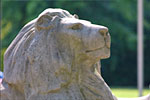
Through the first decade of the twenty-first century the campaign seeks to philanthropically raise £207 million from Imperial’s alumni, staff and friends, and donations from charitable foundations and industry.
Where your support can make a differenceGive now

Imperial’s Centenary Year provides an opportunity to recognise and celebrate members of the Imperial community.
View staff and student portraits